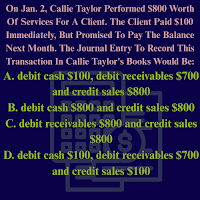On Jan. 2, Callie Taylor Performed $800 Worth Of Services For A Client. The Client Paid $100 Immediately, But Promised To Pay The Balance Next Month. The Journal Entry To Record This Transaction In Callie Taylor's Books Would Be:
When the Callie Taylor performed the services worth $800, then the business
earned the revenue whether the cash is received or not according to Accrual
Basis of Accounting. Here, the client paid $100 in cash and promised to pay
the remaining $700 ($800 - $100) on the next month is a receivables for the Callie
Taylor’s business, which is a current asset and shown on balance sheet under
assets side.
As the business received partially in cash against the services performed,
so we record the following journal entry in the Books
of Accounts of Callie Taylor’s business:
(i)
Cash a/c $100
Sales a/c $100
(Cash Sales Made On 2nd January)
In the above entry, the cash is debited as it is received by the business
of Callie Taylor’s company, so it is increasing and sales is also increasing, as
the business is performed the services and earned the revenue, so it is
credited.
The remaining amount shows receivables i.e., services are performed but the
payment is not received from client, so the following entry is recorded as
shown below:
(ii)
Accounts Receivable a/c $700
Sales a/c $700
(Sales Made On Account / Credit On 2nd January)
In the above entry, accounts receivable is debited as it is increasing and
sales is also credited as it is increasing.
If we join these (i) and (ii) two entries, we get one combined entry as shown below:
Cash a/c $100
Accounts Receivable a/c $700
Sales a/c $800
(Sales Made For Cash And On Account On 2nd January)
So, we record either two entries separately i.e., one for cash and other
one for credit or one single combined entry, the result will be the same.
So, the correct answer of this multiple choice question is A.
The other options (B,C and D) are wrong choices here.

Comments